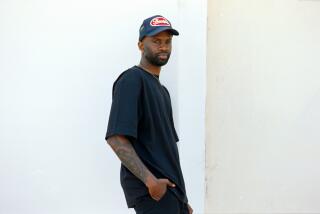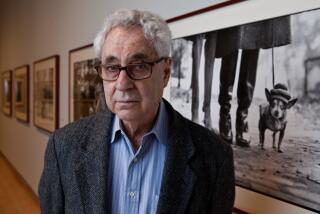Cole Weston, 84; Photographer, Printer Extended Father’s Legacy
- Share via
Cole Weston, a noted photographer and master printer whose work helped enhance the legacy of his father, photographer Edward Weston, has died. He was 84.
In failing health for some time, Weston died Sunday at Community Hospital in Monterey. The cause of death was not announced.
Weston devoted much of his career to his father’s work, serving as his assistant after Edward Weston’s health began to fail due to Parkinson’s disease, and later as his printer and executor of his estate.
“He will be remembered as the person responsible for maintaining the legacy and extending the influence of Edward’s work,” said Robert Sobieszek, head photo curator at the Los Angeles County Museum of Art.
Born in Los Angeles, Weston was the youngest of Edward Weston’s four sons. His brother Brett established a considerable reputation himself as a photographer. Sons Chandler and Neil chose other professions. Cole was the last to die.
As a boy, Cole Weston was intrigued by photography and would later recall that it was not his father who first led him to take pictures but Brett, who took him to Mt. Wilson to make images of the observatories.
After graduating from University High School in West Los Angeles in 1937, Weston went to the Cornish School of Drama in Seattle to study acting.
He later worked at a variety of odd jobs, including a stint at Lockheed Aircraft as a metalsmith helping to build P-38s for 51 cents an hour.
At the outset of World War II, Cole enlisted in the Navy and became a photographer stationed stateside doing public relations work.
After the war, he worked in Los Angeles as a Life magazine photographer, but he later said the job didn’t work out too well. “I had been trained ... to make one or two exposures of a subject. Either you had your image or you didn’t,” Weston wrote in the book “Cole Weston: Fifty Years.”
“When they’d receive my one or two exposed frames the editors were always complaining, ‘Where’s the rest?’ ”
The year 1946 proved to be pivotal for Weston. His father was given a retrospective at the Museum of Modern Art, which turned out to be one of the major photography shows in the museum’s history. But that year his father was diagnosed with Parkinson’s disease. He asked his son to come to Carmel and be his assistant. Under the direct supervision of his father, Cole learned to print negatives using the precise techniques that his father would have used himself.
Weston later wrote that printing each negative was a demanding experience.
“In the beginning, he would come into the darkroom with me,” Weston wrote. “We might spend the entire day on a single negative. Later, I would go into the darkroom and emerge with a print. He would criticize it ... and I would go back in and try again. We worked in such painstaking detail on a hundred or more negatives. [His] exactness was maddening at times.”
As Parkinson’s continued to sap his father’s strength, Weston became more active in helping him take pictures.
“He would tell me where to set up the camera and he got so bad I would literally put his hands on the focusing knob,” Cole Weston told The Times in the early 1980s.
He worked steadily with his father from 1946 until his death in 1958.
Weston’s will specified that Cole could print his negatives as long as the print specified: “Negative by Edward Weston. Print by Cole Weston.” There also was a proviso that no print could sell for less than $30.
Over the years, the Weston images never sold for as little as $30. Images printed by Edward Weston now sell for up to $300,000, while Cole Weston prints can sell for as much $5,000.
Cole Weston’s life in Carmel was varied. He started little theater groups and, for a time, ran a portrait studio. In 1948, he ran for Congress on the ultra-liberal Independent Progressive Party ticket but lost.
After that election, he moved his family to the Garrapata beach area of Big Sur, where he started a trout farm that paid the bills for the next decade.
His personal photographic inclinations took a turn in the late 1940s, when Eastman Kodak tried to interest Edward Weston in color photography by sending him free 8 by 10 Ektachrome.
Although he made a few images in 1947 with Cole’s assistance, the senior Weston didn’t pursue color photography. But Cole did.
“I love color,” Cole told the St. Louis Post-Dispatch some years ago. “I look at color as form, the juxtaposition of colors as contrast.”
And the results of his experiments in color were quite successful.
“He was a master colorist,” said Dennis High, director of the Center for Photographic Art in Carmel. “None of the other Westons did color to any degree, but Cole was enthralled with color and you can see that in his work.”
Perhaps his best-known photograph, “Surf and Headlands, 1958,” appeared on the cover of “Not Man Apart,” a Sierra Club book.
Weston acknowledged his father as a significant influence in his development as a photographer.
“I think as far as visualization and seeing, you can’t help but be influenced in some way,” he told The Times. “How are you going to work with a person for all those years, be with him and see him work and not be affected?”
As a photographer, he was best known for his large-format color landscapes, gorgeous scenics and work with the nude figure in landscape.
“He gravitated toward color landscape work in his own right,” said Arthur Ollman, director of the Museum of Photographic Arts in San Diego. “Unlike his father, he stood back a great deal from his subjects, but he was still quite good.”
Once asked where he ranked himself in a family of internationally known photographers, Cole said, “Well, I don’t know. I think I’m fairly talented. I’ll say I’m third. I’m coming along. I turned to my brother Brett one time and said, ‘You know, Brett, you’re older than I am. I have seven years to catch up with you.’ He looked at me very strangely.
“I think my brother is a very great photographer, but I think my father had more talent.”
Married and divorced several times, Weston is survived by four sons, two daughters and nine grandchildren.
More to Read
The biggest entertainment stories
Get our big stories about Hollywood, film, television, music, arts, culture and more right in your inbox as soon as they publish.
You may occasionally receive promotional content from the Los Angeles Times.










